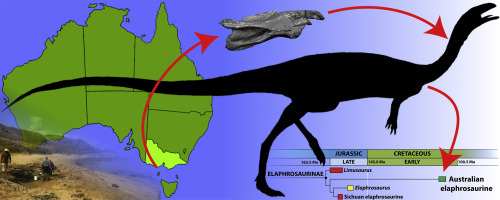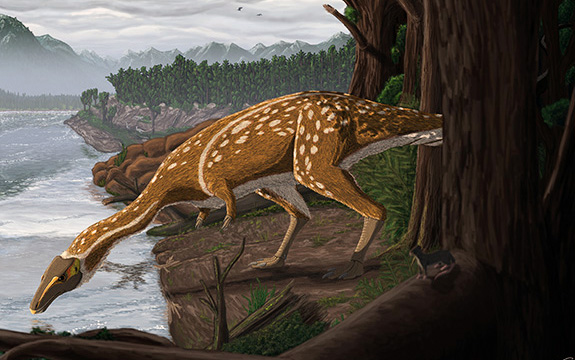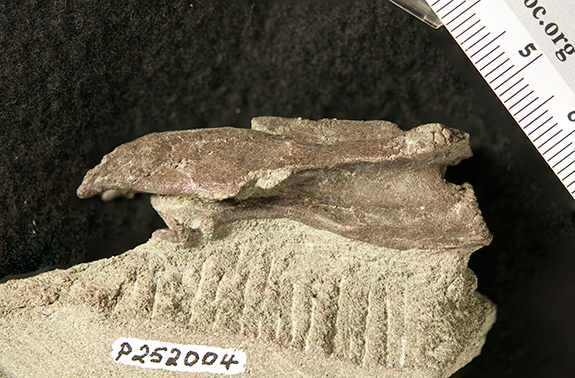The First Elaphrosaurine Theropod Reported from Australia
Curious Cervical Leads to Startling Conclusion
Think of a theropod dinosaur and a ferocious carnivore with a large head and big teeth probably comes to mind. However, the Theropoda is an extremely diverse clade within the Dinosauria, not all of them were big, particularly ferocious or even had teeth. One group the elaphrosaurines, were very bizarre indeed and the discovery of a single neck bone in Victoria has led to the conclusion that these strange, light-weight dinosaurs distantly related to Carnotaurus, roamed Australia in the Early Cretaceous.
A Life Reconstruction of the Australian Elaphrosaurine
Picture credit: Ruairdh Duncan (Swinburne University of Technology, Victoria)
From the Lower Cretaceous of Australia
Volunteer Jessica Parker discovered a 5-centimetre-long bone whilst helping out at the annual Dinosaur Dreaming excavation near Cape Otway, Victoria (2015). The sediments at the site, known as Eric the Red West, date from the late Albian faunal stage of the Lower Cretaceous and are part of the Eumeralla Formation. At first, the bone identified as a cervical vertebra (neck bone), was thought to have come from a pterosaur.
Intriguingly for Swinburne University palaeontologist Dr Stephen Poropat and PhD student Adele Pentland, once the fossil specimen had been prepared it became clear that this was not a bone from the middle portion of the neck of a flying reptile.
Dr Poropat explained:
“Pterosaur neck vertebrae are very distinctive. In all known pterosaurs, the body of the vertebra has a socket at the head end, and a ball or condyle at the body end. This vertebra had sockets at both ends, so it could not have been from a pterosaur.”
The Cervical Vertebra – Evidence of Australia’s First Elaphrosaur
Picture credit: Dr Stephen Poropat
Geologically Much Younger Than Most Elaphrosaurines
The taxonomic affinity of the subfamily Elaphrosaurinae within the Theropoda remains controversial. A number of authors have placed this little-known group, characterised by their small, light, graceful bodies, tiny heads, long necks and reduced forelimbs within the Noasauridae family, which means that they are distantly related to abelisaurids such as Ekrixinatosaurus, Majungasaurus and Carnotaurus.
Most elaphrosaurs are known from the Late Jurassic, but this new elaphrosaur from Australia, lived some forty million years later. Only Huinculsaurus (H. montesi), from the Cenomanian/Turonian (early Late Cretaceous), of Argentina is geologically younger, than the Australian fossil remains.
The Fossil Find Location, Typical Elaphrosaurine Body Plan and Placing the Fossil Find in a Chronological Context

Picture credit: Poropat et al (Gondwana Research)
A Dinosaur of the Polar Region
The discovery of this single, fossilised neckbone adds support to the idea that the elaphrosaurines were geographically and temporally much more widespread than previously thought. The similarity of these dinosaurs to the much better-known ornithomimosaur theropods (bird mimics), could help to explain why few other Cretaceous elaphrosaur specimens have come to light. Fossil material may have been found but misidentified as representing ornithomimids.
As the Cape Otway location would have been situated much further south during the Early Cretaceous (110-107 million years ago), at around a latitude of 76 degrees south, this implies that elaphrosaurines were capable of tolerating near-polar palaeoenvironments.
Elaphrosaurines were Related to Noasaurids
Recently, Everything Dinosaur wrote a post about the discovery of noasaurid from an opal mine close to Lightning Ridge (New South Wales). Noasaurids and elaphrosaurines were related, most scientists classifying them as different branches within the Abelisauroidea. Coincidentally, the New South Wales noasaurid was identified from a single cervical vertebra too. Both it and the Cape Otway elaphrosaurine dinosaur have not been assigned to any genus, but both fossils are likely to represent new species.
To read Everything Dinosaur’s article about the recently discovered noasaurid from New South Wales: Noasaurids from Australia.
The scientific paper: “First elaphrosaurine theropod dinosaur (Ceratosauria: Noasauridae) from Australia — A cervical vertebra from the Early Cretaceous of Victoria” by Stephen F. Poropat, Adele H. Pentland, Ruairidh J. Duncan, Joseph J. Bevitt, Patricia Vickers-Rich and Thomas H. Rich published in Gondwana Research.
For models and replicas of dinosaurs and other prehistoric animals: Dinosaur and Prehistoric Animal Models.
The Everything Dinosaur website: The Everything Dinosaur Website.



